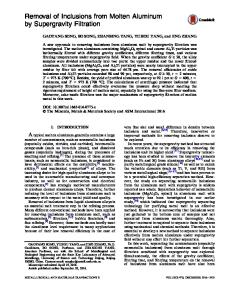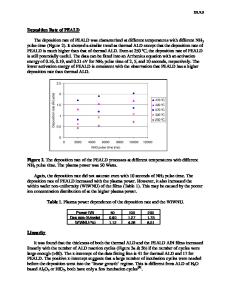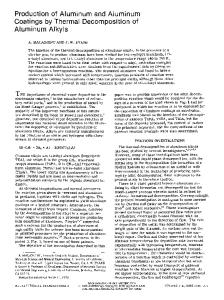Production of aluminum nitride from aluminum metal using molten fluoride
- PDF / 727,195 Bytes
- 10 Pages / 584.957 x 782.986 pts Page_size
- 97 Downloads / 389 Views
The production of aluminum nitride (AlN) from aluminum metal was investigated in this study. The nitridation of Al (in rod, powder, and thin-plate forms) was facilitated by dissolving the Al2O3 thin films formed on the Al samples with a molten fluoride mixture (KF–45 mol% AlF3, KF, or LiF–50 mol% KF). AlN was formed when NH3 gas was supplied to the Al sample (in both solid and liquid forms) wetted by molten fluoride mixture. The lowest temperature at which AlN was successfully produced was 773 K. No AlN was formed when N2 or H2–25% N2 gas was supplied to the Al sample, even when a molten fluoride mixture was used. The reaction rate for the nitridation of Al powder increased with the temperature and reached 99% after 3 h at 1173 K. AlN thin films of 2–5 lm thickness were formed on Al thin plates (0.075–1.0 mm thick) at 873 K.
I. INTRODUCTION A. Production of AlN crystals
Aluminum nitride (AlN) has a wide band gap (6.3 eV), allowing it to emit radiation with a wave length of 210 nm, which corresponds to the deep ultraviolet region. This light emitting property has many potential technological applications, such as for the replacement of fluorescent light, the decomposition of hazardous materials, microfabrication, and even high-density optical recording once high performance has been achieved.1 However, threading dislocations (line defects) are frequent in AlN crystals owing to the mismatch between its lattice constant and that of the substrate, as well as between their thermal expansion coefficients, as heterogeneous substrates such as silicon carbide and sapphire are usually used for the fabrication of AlN-based devices. The development of a cost-effective process for producing self-standing AlN substrates is expected to solve these problems. A number of processes for the production of singlecrystal AlN are currently being investigated. A representative approach is the sublimation method,2–4 in which AlN raw materials are sublimed at temperatures greater than 2273 K, and single-crystal AlN precipitates on substrates such as SiC or AlN. For instance, Makarov et al.2 reported the crystallization of AlN at 2323–2523 K at a growth rate of 50–150 lm/h by sublimation. A chemical vapor deposition method for producing AlN has
Contributing Editor: Yanchun Zhou a) Address all correspondence to this author. e-mail: [email protected] DOI: 10.1557/jmr.2015.22 J. Mater. Res., Vol. 30, No. 5, Mar 14, 2015
http://journals.cambridge.org
Downloaded: 24 Mar 2015
also been developed.5–7 Nagashima et al. investigated a crystallization process that involved AlCl3 (the Al source) and NH3 (the nitridation agent). They termed this process as hydride vapor phase epitaxy and reported that crystallization occurred at 1653 K at a growth rate of 85 lm/h.6 Fukuyama et al. investigated a process that involved the reduction and nitridation of sapphire at 1873–1948 K using mixed N2–CO gas coexisting with graphite; AlN thin films with excellent crystal qualities were obtained.8,9 In addition to gas-phase reactions, solution growth methods hav
Data Loading...











